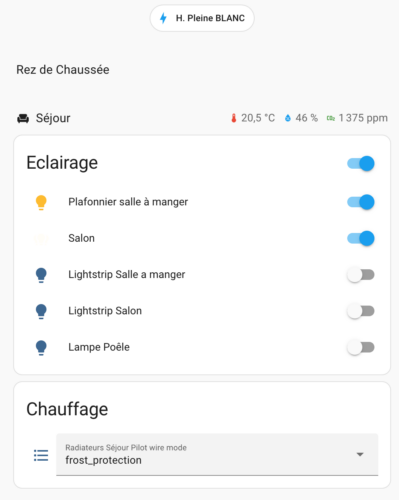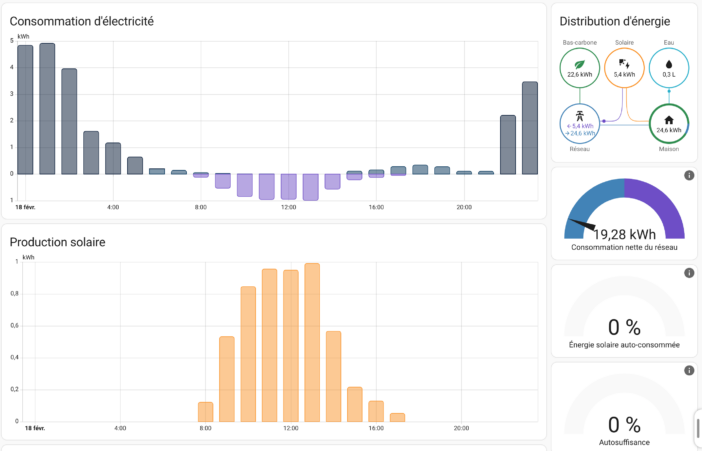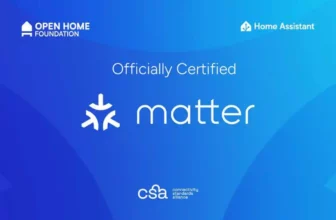In the world of home automation, the most inspiring careers are not always those of technology experts. This is demonstrated by the fascinating story of Damien, a former teacher turned police officer in the Netherlands, whose passion for the connected home dates back to his childhood. Through his testimony on the Home Assistant podcast, we discover how a non-technical user managed to create one of the most sophisticated and functional Home Assistant installations.
If you don't know the official Home Assistant podcast, I invite you to discover it. The shows are generally very interesting. The only downside: of course it's in English. And since it's a podcast, we simply watch a discussion between several speakers, without an explanatory video presentation. It is still possible to activate the display of subtitles and automatic translation on Youtube, which is worth what it's worth, but which already allows non-English speakers to understand most of it.
The last show was particularly interesting with Damien's testimony. You can find the full show here:
So I'll allow myself to make a short summary of the most interesting points.
For Damien, it all started with a creative uncle who simulated a lighting system controlled by clapping his hands, thanks to a switch cleverly hidden under his seat. This first “magical” experience sowed the seeds of what would become a real passion for home automation. Today, Damien's house is a model of home automation integration, combining energy savings, comfort and technical innovations.
His installation, which combines intelligent energy management, centralized multimedia systems and sophisticated automations, demonstrates that modern home automation is accessible to everyone, even without prior technical training. Through his story, we will discover how Home Assistant can transform an ordinary house into a smart and energy-efficient habitat.
Beginnings in home automation
Damien's journey in home automation begins with a touching anecdote from his childhood. At the age of 10-12, his uncle, a particularly creative man, introduced him to what seemed to be “magic”: a lighting system that was activated by the clap of his hands. In reality, his uncle discreetly activated a switch hidden under his seat, but this illusion was enough to awaken a lasting passion in young Damien.
As a teenager, his interest in technology developed through gaming and computer assembly. The first Xbox particularly piqued his curiosity: as soon as he turned it on, he took it apart to explore its internal components. This technical curiosity naturally led him to his first home automation experiments.
In 2008-2009, when he bought his first apartment, Damien took his first concrete steps in home automation with a simple system called “Click On Click Off”, using 860 MHz radio remote controls. Although basic, this system allowed him to control the lighting remotely, but he quickly felt the limitations of a simple remote control.
His quest for a more sophisticated system led him to Fibaro, a high-end Z-Wave solution. Seduced by its elegant interface and integration possibilities, he invested heavily in Z-Wave modules. This transition to a professional system marked the real beginning of his connected home, laying the foundations for what would become a complex and personalized home automation installation.
The heart of the system
At the center of Damien's installation is an impressive technical rack, the true brain of his connected home. Installed in a dedicated room in the basement, this 2.5 meter high rack centralizes all the technical and multimedia equipment of the house.
During construction, Damien showed foresight by requesting that all the cables be routed to this technical room rather than to the traditional electrical panel. This configuration allows him to centrally manage his UniFi network, his audio-video system and all his home automation equipment.
One of the particularities of his installation is its sophisticated multimedia system. In particular, it uses an HDMI over UTP solution to distribute audio and video signals throughout the house. Although this technology sometimes has some timing quirks, Damien has been able to get around these limitations by developing an ingenious solution: a small ESP box with relay, controlled by Home Assistant, which can automatically reset the connection if necessary.
His audio setup includes a Denon receiver that runs a 5.1 system in the living room, with wall-mounted speakers that run invisible cables to the tech rack. The system also plays stereo music in the dining room, creating two separate audio zones and allowing for simultaneous use: kids can watch TV while parents listen to the radio in another room.
To control the whole thing, Damien installed a 22-inch touchscreen in his living room. This screen, mounted on a swivel mount, is powered by an Intel NUC mini-PC that displays the Home Assistant dashboard. This central interface not only controls every aspect of the home, but also serves as a family information hub, displaying the calendar, energy prices, real-time consumption, and weather conditions.

Intelligent energy management
Energy management is one of the most impressive aspects of Damien’s setup. Thanks to a dynamic electricity price contract, it optimizes its consumption hour by hour, thus maximizing energy savings.
Its system is based on a sophisticated integration with Home Assistant which constantly monitors electricity prices. Rates are set 24 hours in advance, allowing optimal planning of consumption. This visibility allows it to identify the most advantageous periods, particularly during the night when rates are generally lower.
Optimization of appliances
The system intelligently manages several energy-intensive appliances:
- The hybrid car and electric bikes are automatically recharged during the three to five cheapest hours of the night
- The dishwasher and washing machine are programmed to run at the most economical times
- Underfloor heating is regulated zone by zone according to solar exposure
Solar production management
With his 25 solar panels installed to the east and west, Damien has even developed a strategy to manage periods when prices become negative. In these situations, the system can automatically turn off solar production to avoid paying for electricity injection into the grid.
This holistic approach to energy management has proven remarkably effective: according to his energy supplier's data, his consumption is consistently among the most optimized, sometimes even below the lowest thresholds usually observed.

Daily automations
One of the most important automations in Damien's home is the bedtime routine. Rather than opting for complex automation based on sensors, he chose a simple and effective approach: a single button on the home's central touchscreen. This solution has proven to be the most reliable and most appreciated by the whole family.
When this “good night” button is pressed, a series of actions are triggered:
- Google Home vocally announces that everything is going to turn off
- The system checks the status of the dishwasher and offers a 30-second delay to start it if necessary
- The lights gradually turn off
- The audio and multimedia systems are turned off
- The technical rack goes into energy-saving mode
- Energy-consuming devices are programmed to operate at the cheapest times of the night
For the children, Damien has set up specific automations. Each room has its own dashboard, allowing teenagers to control their environment. Smart speakers are installed in each room, allowing children to be called for dinner or household chores. The system also allows for screen time management, with the ability to cut off Internet access to certain devices if necessary.
Lighting management has been particularly well thought out, with dimmable lights throughout the house. The central interface allows lighting to be controlled individually or by zones, offering maximum flexibility while maintaining ease of use.
This pragmatic approach to automations, prioritizing simplicity and efficiency over complexity, perfectly illustrates Damien's philosophy: technology should serve the family and not the other way around.
Technology should serve the family and not the other way around.
Technical innovations
Damien's spirit of innovation is particularly illustrated in his personalized technical developments. Faced with the limitations of commercial solutions, he created his own printed circuit boards (PCBs) to meet specific needs.
Radiator control
One of his most notable projects concerns heating management. Unsatisfied with existing solutions for Yaja radiators, he developed his own electronic card integrating an ESP8266. This card allows to control the speed of the fans and to measure the inlet and outlet temperatures of the radiators.
The development process
After studying the operation of the original cards, he designed a circuit integrating:
- A 0-10V output for fan control
- Temperature sensors
- A relay for activation/deactivation
- An interface with Home Assistant via ESPHome
Multimedia management
To solve HDMI synchronization problems, he created a small ESP box with relay, controlled by Home Assistant, which automatically resets the connection if necessary.
Energy optimization
His energy management system integrates custom developments for:
- Control of heating valves by zone
- Accurate measurement of consumption
- Optimization of the charging of electric vehicles according to tariffs.
These innovations demonstrate that with creativity and perseverance, it is possible to overcome the limitations of commercial products to create solutions perfectly adapted to your needs.
Conclusion
Damien's story perfectly illustrates that modern home automation, and particularly Home Assistant, is accessible to everyone, regardless of professional background. From teacher to police officer, his passion led him to develop one of the most sophisticated and functional home automation installations.
His house has become a model of energy efficiency and comfort, where every aspect has been designed to serve the family while optimizing energy consumption. From intelligent heating management to creating your own printed circuit boards and a centralized multimedia system, Damien demonstrates that with perseverance and curiosity, it is possible to create a truly intelligent home environment.
Perhaps the most remarkable aspect of its installation is its ease of use on a daily basis. A single “good night” button triggers a series of coordinated actions, while a central dashboard on a 22-inch screen allows the whole family to easily control their environment. This pragmatic approach, prioritizing efficiency over complexity, makes its installation an inspiring example for all those who wish to embark on the adventure of the connected home.
Its journey demonstrates that Home Assistant, much more than a simple home automation platform, is a powerful tool for creating a truly intelligent, energy-efficient home adapted to the needs of each family.
And you, what have you implemented on your Home Assistant system?






Please remain courteous: a hello and a thank you cost nothing! We're here to exchange ideas in a constructive way. Trolls will be deleted.